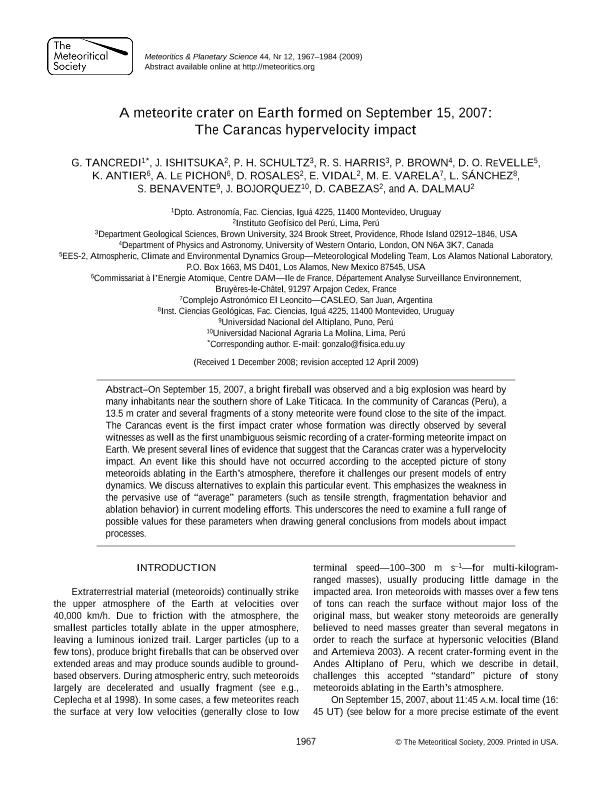Artículo
A meteorite crater on Earth formed on September 15, 2007: The Carancas hypervelocity impact
Tancredi, G.; Ishitsuka, J.; Schultz, P. H.; Harris, R. S.; Brown, P.; Revelle, D. O.; Antier, K.; Pichon, A. Le; Rosales, D.; Vidal, E.; Varela, Maria Eugenia ; Sánchez, L.; Benavente, S.; Bojorquez, J.; Cabezas, D.; Dalmau, A.
; Sánchez, L.; Benavente, S.; Bojorquez, J.; Cabezas, D.; Dalmau, A.
 ; Sánchez, L.; Benavente, S.; Bojorquez, J.; Cabezas, D.; Dalmau, A.
; Sánchez, L.; Benavente, S.; Bojorquez, J.; Cabezas, D.; Dalmau, A.
Fecha de publicación:
12/2009
Editorial:
Meteoritical Soc
Revista:
Meteoritics & Planetary Science
ISSN:
1086-9379
Idioma:
Inglés
Tipo de recurso:
Artículo publicado
Clasificación temática:
Resumen
On September 15, 2007, a bright fireball was observed and a big explosion was heard by many inhabitants near the southern shore of Lake Titicaca. In the community of Carancas (Peru), a 13.5 m crater and several fragments of a stony meteorite were found close to the site of the impact. The Carancas event is the first impact crater whose formation was directly observed by several witnesses as well as the first unambiguous seismic recording of a crater-forming meteorite impact on Earth. We present several lines of evidence that suggest that the Carancas crater was a hypervelocity impact. An event like this should have not occurred according to the accepted picture of stony meteoroids ablating in the Earth's atmosphere, therefore it challenges our present models of entry dynamics. We discuss alternatives to explain this particular event. This emphasizes the weakness in the pervasive use of "average" parameters (such as tensile strength, fragmentation behavior and ablation behavior) in current modeling efforts. This underscores the need to examine a full range of possible values for these parameters when drawing general conclusions from models about impact processes.
Palabras clave:
crater
,
hypervolicity impact
,
Peru
,
Carancas
Archivos asociados
Licencia
Identificadores
Colecciones
Articulos(ICATE)
Articulos de INST.D/CS ASTRONOMICAS D/LA TIERRA Y DEL ESPACIO
Articulos de INST.D/CS ASTRONOMICAS D/LA TIERRA Y DEL ESPACIO
Citación
Tancredi, G.; Ishitsuka, J.; Schultz, P. H.; Harris, R. S.; Brown, P.; et al.; A meteorite crater on Earth formed on September 15, 2007: The Carancas hypervelocity impact; Meteoritical Soc; Meteoritics & Planetary Science; 44; 12; 12-2009; 1967-1984
Compartir
Altmétricas



